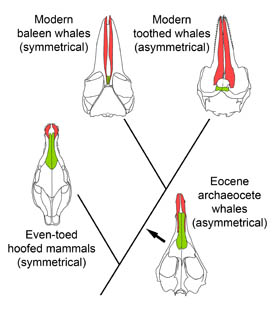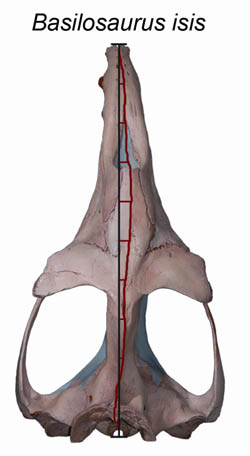http://www.youtube.com/watch?v=WfCCo6KUZogSkewed skulls may have helped early whales discriminate the direction of sounds in water and are not solely, as previously thought, a later adaptation related to echolocation. University of Michigan researchers report the finding in a paper published online in the Proceedings of the National Academy of Sciences.Asymmetric skulls are a well-known characteristic of the modern whale group known as odontocetes (toothed whales). These whales also have highly modified nasal structures with which they produce high-frequency sounds for echolocation—a sort of biological sonar used to navigate and find food. The other modern whale group, mysticetes (baleen whales), has symmetrical skulls and does not echolocate.

Evolutionary relationships between terrestrial even-toed hoofed mammals (artiodactyls), Eocene archaeocete whales, and modern toothed and baleen whales. The skulls of archaeocetes and toothed whales are asymmetrical, but the skulls of artiodactyls and baleen whales are symmetrical. Asymmetry evolved in archaeocetes and was later exaggerated in toothed whales. Asymmetry was reduced in baleen whales. (Image courtesy Julia M. Fahlke.)

Cast of the skull of Basilosaurus isis, seen from the top, showing the deviation of the midline of the skull (red) from a straight line (black) connecting the tip of the snout with the back of the skull. Note that most of the midline lies to the right of the straight line, meaning that the skull is bent to the left. (Image courtesy Julia M. Fahlke.)
“Finally it dawned on me: Maybe archaeocete skulls really were asymmetrical,” Fahlke said. She didn’t have to go far to explore that idea; the U-M Museum of Paleontology houses one of the world’s largest and most complete archaeocete fossil collections. Fahlke began examining archaeocete skulls, and to her astonishment, “they all showed the same kind of asymmetry—a leftward bend when you look at them from the top down,” she said.To study the asymmetry in a more rigorous way, Fahlke and colleagues selected six well-preserved skulls that showed no signs of artificial deformation and measured those skulls’ deviation from a straight line drawn from snout to back of skull. For comparison, they made similar measurements of the decidedly symmetrical skulls of artiodactyls, the group of terrestrial mammals from which whales evolved.”Taken together, the six skulls deviate significantly from symmetry,” Fahlke said. “Taken individually, four of them deviate significantly.” The other two appear asymmetrical, but their measurements fall within the range of the symmetrical comparative sample.”This shows that asymmetry existed much earlier than previously thought—before the baleen whales and toothed whales split,” Fahlke said. “This means that the earliest baleen whales must have had asymmetrical skulls, which later became symmetrical.”The authors also show in their paper that archaeocete asymmetry is a three-dimensional torsion, or twist that affects the whole skull, rather than only a two-dimensional bend. Interestingly, archaeocetes have structures similar to those that are known in toothed whales to function in directional hearing in water: fat bodies in their lower jaws that guide sound waves to the ears, and an area of bone on the outside of each lower jaw thin enough to vibrate and transmit sound waves into the fat body. This adaptation, along with the acoustic isolation of the ear region from the rest of the skull, appears to have evolved in concert with asymmetry.The link between asymmetry and directional hearing is not unique to whales, Fahlke said.”Owls have asymmetrical ear openings, which help them decompose complex sounds and interpret differences and space and time, so that they can discriminate the rustling of leaves around them from the rustling of a mouse on the ground,” Fahlke said. “Such ability would also be helpful when you’re trying to detect prey in the water, so we interpret that the same kind of mechanism was operating for archaeocetes.”


